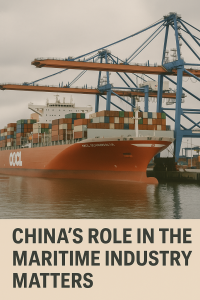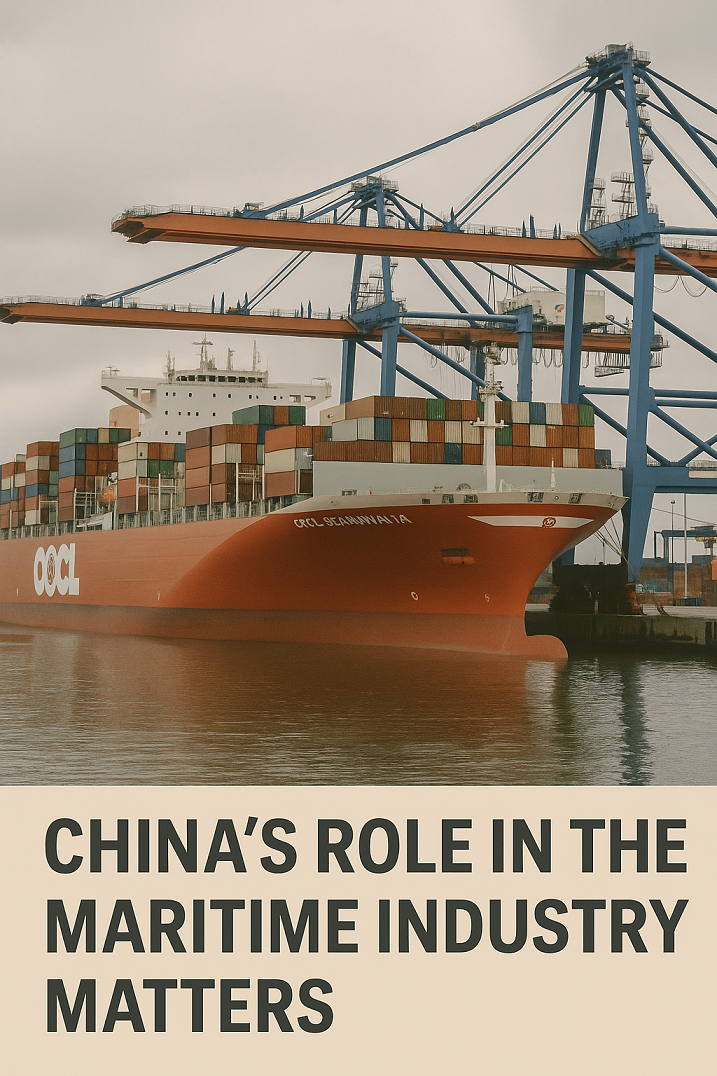Discover how China is leading the global maritime industry through innovation, infrastructure, green shipping, and digital transformation. This comprehensive guide explores strategies, stats, and future directions.
Why China’s Role in the Maritime Industry Matters

The global maritime industry is the backbone of international trade, responsible for transporting over 80% of world merchandise by volume, according to UNCTAD. At the helm of this sector stands China—a nation whose rise to maritime dominance is as strategic as it is transformative. From port capacity to shipbuilding, and from digital logistics to green shipping, China is setting benchmarks that are reshaping the global maritime landscape.
China is not merely participating in the global maritime industry—it is defining it. The country is home to 7 of the world’s top 10 busiest ports, led by Shanghai, which handled more than 47 million TEUs in 2023 (MarineTraffic, 2024). Chinese shipbuilders like China State Shipbuilding Corporation (CSSC) are dominating the global newbuilding order book, while the Belt and Road Initiative (BRI) extends China’s maritime influence far beyond its shores.
For maritime professionals, regulators, and students alike, understanding China’s maritime leadership isn’t optional—it’s essential.
–
Key Developments Driving China’s Maritime Ascendancy
Dominance in Port Infrastructure
China’s ports are the busiest and most advanced in the world. According to Lloyd’s List Intelligence, seven of the top 10 container ports in 2023 were in China: Shanghai, Ningbo-Zhoushan, Shenzhen, Guangzhou, Qingdao, Tianjin, and Hong Kong.
The Port of Ningbo-Zhoushan, for example, became the first port globally to handle over 1.2 billion tons of cargo in a single year (2023). China’s investment in deepwater ports, automated cranes, and AI-enabled container terminals reflects a clear national priority: make maritime trade faster, cleaner, and smarter.
Leading the World in Shipbuilding
China currently controls over 50% of the global shipbuilding market share (Clarksons Research, 2024). CSSC, one of the largest shipbuilding conglomerates globally, produces everything from LNG carriers to ultra-large container vessels and military ships.
Recent advancements include the construction of the world’s first dual-fuel methanol-powered containerships for Maersk and autonomous vessel prototypes in partnership with Wärtsilä and DNV.
Smart Ports and Digital Innovation
In tandem with physical expansion, China is rapidly digitizing port operations. The Port of Tianjin has become a model smart port using 5G networks, edge computing, and autonomous vehicles. The integration of blockchain through platforms like TradeLens (a collaboration with IBM and Maersk) is improving cargo visibility and reducing paper-based bottlenecks.
Chinese logistics giants like COSCO Shipping and Alibaba’s Cainiao are leveraging AI and Internet of Things (IoT) to synchronize inland and maritime transport corridors—key components of China’s Maritime Silk Road.
Green Shipping and Sustainability
China has also emerged as a leader in maritime decarbonization. The country’s Ministry of Transport launched the “Green Port” initiative, requiring major ports to adopt shore power, electrified cranes, and low-emission vessels.
Moreover, China is piloting ammonia-fueled and hydrogen-powered ships, while firms like CSSC and China Classification Society (CCS) are investing in carbon capture-ready vessel designs. According to the IMO’s 2023 GHG Strategy, aligning with China’s ambitions is essential to achieving global decarbonization goals.
–
Challenges Facing China’s Maritime Dominance
While China’s maritime growth is impressive, it’s not without friction. Several key challenges stand out:
Geopolitical Pressures
The South China Sea remains a flashpoint for geopolitical tension. Increasing military activity and territorial disputes can disrupt shipping lanes and diplomatic trust. China’s dominance in the BRI maritime corridors has also raised concerns among Western governments and trade blocs.
Environmental Trade-Offs
Massive port expansions and dredging operations have raised environmental concerns. Despite its commitment to green ports, China still ranks among the top maritime polluters due to its fleet size. Balancing economic growth with marine ecosystem preservation remains a delicate act.
Talent Shortage in High-Tech Maritime Sectors
While China has invested in maritime education through academies like Dalian Maritime University and Shanghai Maritime University, there’s a growing skills gap. Emerging roles in AI navigation, emissions monitoring, and cybersecurity demand a new kind of seafarer—one equipped for digital transformation.
–
Real-World Applications and Case Studies
Shanghai Port: A Global Model for Mega-Hub Efficiency
Shanghai’s Yangshan Deep-Water Port, connected by the world’s longest sea bridge, is 100% automated. It uses AGVs (Automated Guided Vehicles), AI-powered control centers, and big data analytics to achieve near-flawless cargo movement with minimal emissions.
The port also served as a COVID-19 logistics backbone, maintaining uninterrupted supply chains even during China’s lockdown periods—an example of resilience in crisis.
COSCO Shipping: Integrating Fleet, Tech, and Trade
COSCO is more than a shipping company. It’s a vertically integrated logistics powerhouse. By combining port operations, shipping lines, freight forwarding, and e-commerce logistics, COSCO creates end-to-end global trade routes that offer both scale and speed.
In 2023, COSCO launched its AI-driven Fleet Operation Centre, allowing real-time monitoring of fuel use, emissions, weather routing, and cargo performance across its fleet of over 1300 vessels.
BRI Maritime Projects in Africa and Europe
Through its BRI strategy, China has financed and constructed port terminals in Djibouti, Greece (Piraeus), and Pakistan (Gwadar). While beneficial to host countries in terms of infrastructure and jobs, critics argue these projects can lead to debt dependency and geopolitical influence.
Still, the ports themselves—especially Piraeus—have flourished. In less than a decade, COSCO transformed the Greek port into a top-5 European hub.
–
Future Outlook: What’s Next for China’s Maritime Leadership?
Looking ahead to 2030 and beyond, China’s maritime leadership is expected to deepen in the following ways:
- Energy Transition: More pilot projects using green methanol, ammonia, hydrogen, and wind-assisted propulsion.
- Digital Ecosystem Expansion: Unified maritime data platforms across Asia, powered by AI and satellite constellations like BeiDou.
- Global Regulatory Engagement: China is increasingly active in IMO decarbonization policy and STCW revisions to shape global maritime governance.
- Polar Silk Road: With Arctic sea ice receding, China is investing in northern routes via the Russian Arctic, potentially halving transit times to Europe.
–
Frequently Asked Questions (FAQs)
Why is China so dominant in shipbuilding?
China has large-scale government support, vast industrial capacity, and the ability to offer full-service shipyards—from hull construction to electronics integration. Its vertical supply chains and economies of scale drive down costs.
Are China’s smart ports the most advanced in the world?
Yes, ports like Shanghai, Ningbo-Zhoushan, and Tianjin are equipped with AI, 5G, and autonomous technologies that rival or exceed those in Singapore and Rotterdam.
How does the Belt and Road Initiative affect global maritime trade?
It connects over 60 countries through Chinese-funded port and infrastructure projects, expanding China’s trade routes and geopolitical influence.
Is China investing in green maritime technology?
Absolutely. From shore power to low-emission fuels and carbon capture readiness, China is rapidly becoming a key player in maritime sustainability.
What risks does China’s maritime dominance pose?
Geopolitical tensions, environmental degradation, and dependency among developing countries are key concerns. Transparency and global cooperation will be essential moving forward.
How does China train its maritime professionals?
Institutions like Dalian Maritime University offer advanced degrees in naval architecture, marine engineering, and logistics, often incorporating simulation, VR, and international IMO model course standards.
–
Conclusion: Navigating a Future Shaped by China
China is not just participating in maritime trade—it is reshaping it. With unmatched port infrastructure, green shipping initiatives, and digital logistics innovation, the country is well-positioned to lead the maritime world into the future. Yet this leadership comes with responsibilities: fostering global collaboration, upholding sustainability, and ensuring transparent governance.
For students, seafarers, and policymakers, understanding China’s maritime influence is critical—not just for navigating today’s waters, but for steering the ships of tomorrow.
References
- UNCTAD Review of Maritime Transport
- MarineTraffic Port Rankings
- Clarksons Research
- Lloyd’s List Intelligence
- IMO GHG Strategy 2023
- China State Shipbuilding Corporation (CSSC)
- Port of Shanghai
- COSCO Shipping
- Dalian Maritime University
- Shanghai Maritime University
- China Ministry of Transport
- Belt and Road Portal
- DNV – Maritime Decarbonization
- World Bank Belt and Road Impact

